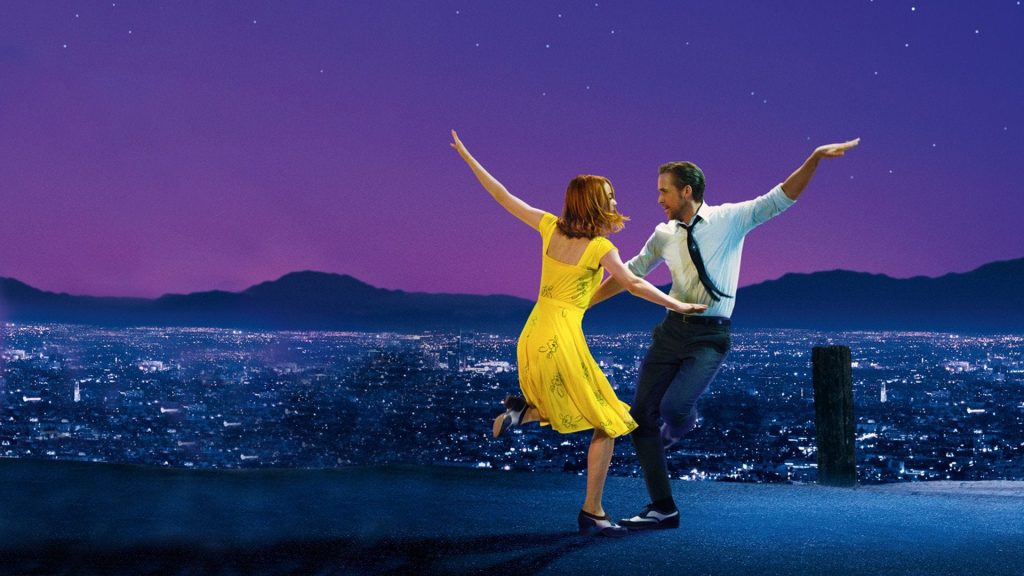La La Land, Damien Chazelle’s follow-up to Whiplash, was the dark horse of 2016 films. It started as a limited release, yet it was in theaters nationwide by Christmas. Despite its quiet start, the movie musical quickly gained traction in the industry. The movie is celebrated for its enchanting blend of nostalgia and modernity, seamlessly marrying the classic charm of Hollywood musicals with a contemporary storyline. The film’s stunning cinematography captures the magic of Los Angeles and enhances the emotional impact of the narrative.

La La Land Musical Movie Magic: What Makes It Work
The jazz-themed musical, featuring Emma Stone and Ryan Gosling, took the industry by surprise when it secured seven Golden Globes and14 Oscar nominations, with two songs from La La Land taking spots for original songs:
- Best Picture
- Actor in a Leading Role
- Actress in a Leading Role
- Cinematography
- Costume Design
- Directing
- Film Editing
- Music
- Music (Original Song)
- Production Design
- Sound Editing
- Sound Mixing
- Writing (Original Screenplay)
Prior to La La Land, only two movies in history have secured 14 Oscar nominations – All About Eve (1950) and Titanic (1997). Mary Poppins (1964), a beloved classic movie musical, received 13 Oscar nominations but didn’t win Best Picture.
So, to the question burning on all of our minds:
What makes this movie musical successful?
Compared to its fellow Oscar contenders, La La Land isn’t a hearty drama, nor does it touch on serious issues. Chazelle’s romantic musical, set in Los Angeles, doesn’t immerse its audience into bouts of depression or isolation. Instead, La La Land revolves around two attractive people chasing their dreams, and at its core exists a romantic comedy — the type of movie that rarely wins Oscars but tells a very human story in a directly relatable (if somewhat more glamorous) way.
For a movie musical to succeed, the performances must rivet and move the audience. La La Land succeeds at this unconventionally — while Emma Stone and Ryan Gosling are strong actors, neither are experienced in singing and dancing. Nevertheless, audiences and critics alike have agreed that their performances do what matters most: captivate.
Ann Hornaday of The Washington Post wrote in her review of La La Land: “They have the unforced grace of natural performers, lending an offhand rakishness to every step they take.”
What makes “La La Land” different than other romantic comedies?
Chazelle uses the first act of the movie to establish the main characters’ individual careers and passions. The dynamics between Mia and Sebastian are effortless. Instead of forcing the characters to be dependent on each other to move the film forward, it allows the audience to bond with both characters on a personal level before the characters become fully entwined. These fully fleshed, individualized characters are what propels the story. And it is the attention to the individual details in the characters that allow Stone and Gosling to shine.
Another factor in La La Land’s success is how the film pays loving homage to movie musicals before it, perfectly balancing affection with clever innovation. The movie isn’t trying to reinvent the wheel. Instead, it gives nods to movie musicals like Singin’ in the Rain, Grease, Sweet Charity, Boogie Nights, and Shall We Dance, achieving an intoxicating blend of freshness and nostalgia for the audience.
Chazelle didn’t set out to deliver a movie focused on serious issues, which would more than likely cloud the movie’s plot. He set out to create two relatable characters reminiscent of earlier movie musicals meant to break the monotony of superheroes and far-fetched action movies dominating today’s film industry. And it worked. Amazingly well.
Build Musical Theatre Skills at NYFA
In the quest to build a powerful performance, professionals must have a full arsenal of tools to draw upon. NYFA musical theatre instructors have toured various Broadway and touring productions, regional theaters, operas, movie musicals, and television shows. They can offer students real-world training that will prepare them to offer their best possible performance.
Start your own movie musical adventure today with the New York Film Academy’s Musical Theatre School.